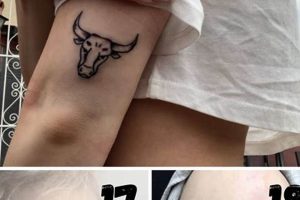Representations of Medusa, the Gorgon of Greek mythology, have become a popular choice for body art. These designs range from simplistic line drawings to intricate, colorful portrayals often incorporating snakes, scales, and her iconic gaze. A typical depiction might feature her head, complete with serpentine hair and a fierce expression, or focus on specific symbolic elements like daggers or wings.
Choosing this mythological figure for a tattoo can convey a variety of meanings, including power, protection, feminine rage, and transformation. Historically, Medusa was a complex figure representing both monstrous qualities and a victim of circumstance. In modern interpretations, she is often reclaimed as a symbol of female strength and a defiant response to injustice. This historical and symbolic richness makes her a compelling subject for permanent body art.
This exploration will delve into various artistic styles, placement considerations, and symbolic interpretations associated with Medusa tattoos, providing comprehensive guidance for those considering this powerful imagery.
1. Placement
Placement is a crucial element in Medusa tattoo design, influencing not only the visual impact but also the personal meaning imbued within the artwork. The chosen location on the body can amplify the symbolic significance of the Gorgon, creating a powerful statement.
- Arm/Forearm
Positioning a Medusa tattoo on the arm or forearm offers excellent visibility and allows for detailed depictions. This placement can represent strength, warding off negativity, and wielding power openly. A larger design on the forearm can showcase intricate details of the snakes and scales, while a smaller, simpler design on the wrist can serve as a subtle reminder of inner resilience.
- Thigh/Leg
Medusa tattoos on the thigh or leg often symbolize reclaiming personal power and overcoming trauma. The leg, associated with movement and progress, can represent the journey of healing and transformation. This placement also allows for larger designs that can incorporate elements of the Gorgon’s story, such as Perseus or her victims turned to stone.
- Back/Ribcage
The back and ribcage offer larger canvases for more elaborate depictions of Medusa. This placement can represent a protective shield, guarding against unseen threats. The curvature of the spine can be incorporated into the design, enhancing the flow and impact of the serpentine hair. Ribcage placements, closer to the heart, can signify deeply personal meanings related to overcoming adversity.
- Chest/Sternum
A Medusa tattoo positioned over the heart or sternum signifies courage, protection, and a connection to inner strength. This placement often emphasizes the apotropaic nature of the Gorgon, acting as a symbolic shield against negative energies. Smaller, minimalist designs can be particularly effective in this location.
Ultimately, the chosen placement enhances the personal narrative embedded within the Medusa tattoo. Careful consideration of these locations, combined with individual interpretations of the Gorgon’s symbolism, creates a powerful and meaningful piece of body art.
2. Style (realism, traditional, etc.)
Artistic style significantly impacts the overall aesthetic and symbolic representation of a Medusa tattoo. Different styles lend themselves to varying interpretations of the Gorgon’s image, from emphasizing her monstrous nature to highlighting her tragic victimhood. Selecting an appropriate style ensures the tattoo effectively communicates the intended message.
Realism, with its focus on lifelike detail and anatomical accuracy, can create a visually striking and intense Medusa. This style often emphasizes the serpentine features, scales, and the intensity of her gaze. The use of light and shadow enhances the three-dimensional effect, bringing the Gorgon to life on the skin. Traditional styles, characterized by bold lines, solid colors, and limited shading, offer a classic and timeless approach. This style can effectively portray Medusa’s iconic features, such as the snakes and her fierce expression, in a simplified yet powerful manner. Neo-traditional tattoos, building upon traditional foundations with broader color palettes and more detailed imagery, allow for a more dynamic and expressive portrayal of the Gorgon. Geometric designs, using intricate patterns and shapes to form the image, offer a modern and abstract interpretation. This style can focus on the symbolic representation of Medusa, such as protection and transformation, rather than a literal depiction.
The chosen style influences not only the visual impact but also the conveyed narrative. A realistic Medusa might emphasize her fearsome power, while a traditional or neo-traditional depiction could focus on her symbolic representation as a protector or survivor. Geometric styles often highlight the abstract concepts associated with the Gorgon, such as feminine strength and resilience. Selecting the appropriate style ensures the final artwork effectively reflects the desired message and aesthetic preferences.
3. Color palettes
Color palettes play a significant role in shaping the overall mood and symbolic meaning of Medusa tattoo designs. Strategic color choices can amplify the intended message, whether focusing on the Gorgon’s monstrous nature, her victimhood, or her modern interpretations as a symbol of feminine power. Monochromatic palettes, utilizing black ink with varying levels of gray shading, create a classic and timeless aesthetic. This approach often emphasizes the form and texture of the design, highlighting the details of the snakes, scales, and facial expression. Black and gray can evoke a sense of darkness, mystery, and seriousness, aligning with Medusa’s traditional representation as a fearsome creature. Adding red accents can introduce an element of danger and aggression, symbolizing the Gorgon’s venomous nature and potent gaze.
Vibrant color palettes offer a more contemporary and expressive approach to Medusa tattoos. Green, often associated with snakes and reptiles, can be used to emphasize the serpentine features of the Gorgon. Purple, traditionally associated with royalty and power, can represent Medusa’s status as a formidable figure in Greek mythology. Gold can be incorporated to symbolize her divine origins and the inherent power she possessed. Contrasting colors, such as red and green or blue and orange, can create a visually striking effect, drawing attention to specific details and enhancing the overall dynamism of the design. These vibrant choices can also represent the multifaceted nature of Medusa, acknowledging her complexity as both a monster and a victim.
Careful color selection is essential for effectively conveying the desired narrative within a Medusa tattoo. Monochromatic palettes offer a classic and serious tone, often focusing on the darker aspects of the Gorgon’s mythology. Vibrant color schemes allow for a more expressive and modern interpretation, emphasizing themes of transformation, power, and resilience. Ultimately, the chosen color palette should harmonize with the selected style and placement to create a cohesive and impactful piece of body art.
4. Incorporating Symbols (Snakes, Daggers)
Symbolic elements play a crucial role in enriching the narrative and visual impact of Medusa tattoos. These additions, often drawn from Greek mythology and traditional iconography, deepen the complexity of the Gorgon’s representation, allowing for personalized interpretations and a more profound connection to the artwork.
- Snakes
Snakes, the most prominent symbol associated with Medusa, represent transformation, primal energy, and cyclical renewal. Their presence in a tattoo can emphasize the Gorgon’s connection to the earth and her chthonic power. The depiction of the snakes whether coiled, striking, or intertwined can further convey specific meanings, such as aggression, protection, or hidden knowledge. Furthermore, the number of snakes depicted can hold symbolic weight, referencing different mythological interpretations.
- Daggers
Daggers often accompany Medusa imagery, symbolizing severance, sacrifice, and the wielding of power. They can represent the act of Perseus beheading Medusa or symbolize the Gorgon’s own destructive potential. Placement of the dagger, such as held in Medusa’s hand or piercing her head, can further refine the intended meaning. The style of the dagger, whether simple or ornate, can also contribute to the overall aesthetic and historical context of the tattoo.
- Scales
Reptilian scales, often incorporated into Medusa tattoo designs, symbolize protection, resilience, and adaptability. They represent the Gorgon’s impenetrable defenses and her ability to withstand adversity. The texture and pattern of the scales can add visual interest to the tattoo, enhancing its aesthetic appeal. The placement of scales, whether covering the face, body, or incorporated into the background, can further contribute to the overall composition and symbolic meaning.
- Wings
While not always present in traditional depictions, wings are sometimes incorporated into Medusa tattoos, symbolizing freedom, transcendence, and the duality of her nature. They represent the Gorgon’s ability to rise above her circumstances or her connection to both the earthly and divine realms. The style of the wings, whether feathered like a bird’s or leathery like a bat’s, can further contribute to the overall symbolism and aesthetic of the tattoo. For example, feathered wings might suggest a connection to the heavens, while bat-like wings could emphasize a darker, more monstrous aspect.
The careful selection and incorporation of these symbolic elements enhance the depth and complexity of Medusa tattoos. They allow for a more personalized and meaningful representation of the Gorgon, transforming a simple image into a powerful statement of individual interpretation and connection to mythology.
5. Size and Detail
Size and detail are integral considerations in Medusa tattoo design, significantly impacting the visual impact and feasibility of realizing the desired artistic vision. The level of detail dictates the complexity and intricacy of the design, influencing the choice of style and placement. A highly detailed Medusa, featuring intricate scales, individual snakes, and nuanced facial expressions, necessitates a larger canvas to avoid a muddled or visually confusing result. Smaller tattoos, while potentially impactful, may limit the level of detail achievable, favoring simpler linework and bolder shapes. For example, a small Medusa face on the wrist might focus on the iconic serpentine hair and piercing gaze, omitting finer details like individual scales.
Conversely, larger pieces, often placed on the back, thigh, or chest, provide ample space for intricate details, allowing for realistic depictions of scales, dynamic snake movements, and expressive facial features. Larger sizes also accommodate the incorporation of background elements, such as flowers, daggers, or architectural ruins, further enriching the narrative and visual depth of the tattoo. A full-back piece might depict Medusa’s entire figure, intertwined with snakes and surrounded by symbolic elements from her myth. The interplay between size and detail also influences the time and cost of the tattooing process. Highly detailed, large-scale pieces require multiple sessions and a greater investment, demanding careful planning and consideration of the artist’s skill level.
Ultimately, the chosen size and level of detail must align with the individual’s aesthetic preferences, budget, pain tolerance, and the desired symbolic representation. A balance must be struck between the desired complexity of the design and the practical limitations imposed by size and placement. Careful consideration of these factors ensures a successful and satisfying outcome, resulting in a Medusa tattoo that effectively communicates the intended message with visual clarity and artistic impact.
Tips for Choosing a Medusa Tattoo
Selecting a Medusa tattoo design requires careful consideration of various factors to ensure a meaningful and visually compelling result. These tips offer guidance for navigating the decision-making process, emphasizing both aesthetic and symbolic considerations.
Tip 1: Research Different Depictions: Explore various artistic interpretations of Medusa, from classical portrayals to modern adaptations. This research expands understanding of the Gorgon’s multifaceted symbolism and informs design choices.
Tip 2: Consider Placement Carefully: Placement impacts both visibility and symbolic meaning. Reflect on the desired message and choose a location that complements the design and personal significance.
Tip 3: Choose a Style that Resonates: Artistic style significantly influences the overall aesthetic. Select a style that aligns with personal preferences and effectively conveys the intended message, whether realism, traditional, or geometric.
Tip 4: Reflect on Color Palette: Color choices impact mood and symbolism. Consider the desired tone and message when selecting a color palette, whether monochromatic, vibrant, or incorporating specific symbolic colors.
Tip 5: Incorporate Meaningful Symbols: Enhance the narrative by incorporating symbolic elements like snakes, daggers, scales, or wings. These additions deepen the complexity and personal significance of the tattoo.
Tip 6: Balance Size and Detail: Strive for a balance between the desired level of detail and the chosen size and placement. Intricate details require larger canvases to avoid a cluttered appearance.
Tip 7: Consult with a Reputable Artist: Collaboration with a skilled tattoo artist is crucial. Discuss ideas, explore options, and ensure the artist’s style aligns with the desired aesthetic and level of detail.
Careful consideration of these tips empowers informed decisions, resulting in a Medusa tattoo that resonates with personal meaning and artistic excellence. This thoughtful approach ensures a powerful and enduring piece of body art.
By following these guidelines, individuals can embark on the journey of acquiring a Medusa tattoo with confidence, ensuring a result that reflects both personal significance and artistic integrity. The final piece will serve as a powerful statement of individual expression and a lasting connection to the enduring power of mythology.
Frequently Asked Questions about Medusa Tattoos
This section addresses common inquiries regarding Medusa tattoos, offering clarity on practical and symbolic considerations.
Question 1: What does a Medusa tattoo symbolize?
Medusa tattoos can hold multiple meanings, including protection, feminine power, transformation, and resilience. The specific interpretation often depends on individual experiences and the chosen design elements.
Question 2: Are Medusa tattoos considered feminine?
While Medusa is a female figure, the symbolism of her image transcends gender. Individuals of all genders choose Medusa tattoos to represent themes of power, protection, and overcoming adversity.
Question 3: How painful is a Medusa tattoo?
Pain levels vary depending on placement, size, and individual pain tolerance. Areas with thinner skin or closer to bone tend to be more sensitive. Consulting with a tattoo artist can provide further insight into pain management techniques.
Question 4: What are common design elements incorporated with Medusa?
Common elements include snakes, daggers, scales, wings, and floral motifs. These additions further personalize the design and contribute to the overall symbolic meaning.
Question 5: How much does a Medusa tattoo typically cost?
Cost varies based on size, detail, artist experience, and geographical location. Consulting with a reputable artist provides accurate pricing based on individual design specifications.
Question 6: How long does it take for a Medusa tattoo to heal?
Healing typically takes 2-4 weeks. Proper aftercare, including regular cleaning and moisturizing, is crucial for optimal healing and preventing infection.
Understanding these frequently asked questions provides valuable insights for those considering a Medusa tattoo. Careful consideration of these factors ensures informed decisions regarding design, placement, and aftercare, ultimately resulting in a meaningful and well-executed piece of body art.
Further exploration of related topics, such as artist selection and aftercare practices, can further enhance understanding and preparation for the tattooing process.
Medusa Tattoo Ideas
Exploration of Medusa tattoo ideas reveals a rich tapestry of symbolic meanings and artistic possibilities. Placement considerations, stylistic choices, color palettes, and incorporated symbols contribute to the multifaceted nature of these designs. From representations of feminine power and protection to overcoming adversity and embracing transformation, Medusa tattoos offer a potent form of self-expression.
The enduring appeal of Medusa as a subject for body art underscores the power of mythology to resonate with contemporary experiences. Careful consideration of design elements ensures a meaningful and impactful representation of this complex figure, allowing individuals to connect with her enduring symbolism in a deeply personal way. Ultimately, a Medusa tattoo serves as a powerful reminder of the transformative potential within each individual.







